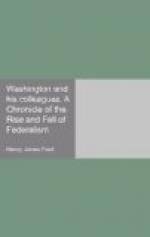At the time when Genet, favored by the exasperated state of Western sentiment over the navigation of the lower Mississippi, was promoting an attack upon the Spanish posts, the Administration had already been engaged for a long time in efforts to secure “full enjoyment of that navigation,” as well as a settlement of the southwestern boundary. In December, 1791, Washington nominated William Carmichael, charge d’affaires in Spain, and William Short, then charge d’affaires in France, commissioners to make a treaty. Their efforts proved unsuccessful, and in 1794 the Spanish commissioner in the United States gave notice that they were not acceptable personally, and that it “was hoped that some other person would be appointed, with full powers, to settle this treaty, and graced with such a character as became the royalty to which he was accredited.” Washington then nominated Thomas Pinckney, at that time minister in London, as minister plenipotentiary in Spain. When Pinckney arrived on the scene he was met with the dilatory methods then characteristic of Spanish diplomacy, and finally he had to bring matters to an issue by demanding his passports. His determination so impressed the Spanish Government that it finally consented to a treaty, October 27, 1795, which fixed the southern boundary of the United States and opened the Mississippi River to navigation. The boundary line was to run east along the thirty-first parallel of latitude from the Mississippi to the Appalachicola, thence along the latter river to its junction with the Flint, thence to the headwaters of the St. Mary’s, and along its course to the Atlantic Ocean. The free navigation of the Mississippi was coupled with the privilege of depositing merchandise at New Orleans “without paying any other duty than a fair price for the hire of the stores.” This privilege was to be continued after three years, or “an equivalent establishment” on the banks of the Mississippi was to be assigned to citizens of the United States—a provision which was not free from ambiguities and which furnished fresh material for controversy a few years later.
CHAPTER VII
A SETTLEMENT WITH ENGLAND




